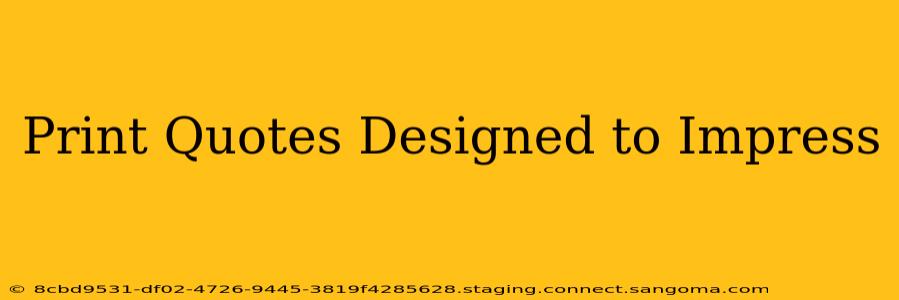Finding the perfect print quote can be challenging. Whether you're a seasoned professional or a first-time client, navigating the world of print quotes requires understanding the variables involved and knowing how to effectively compare options. This guide will equip you with the knowledge to select print quotes that not only meet your budget but also exceed your expectations in quality and service.
What Factors Influence Print Quotes?
Several factors contribute to the price variation you'll see in print quotes. Understanding these will empower you to make informed decisions and avoid hidden costs.
-
Quantity: The number of prints you need significantly impacts the price per unit. Larger print runs generally result in lower per-unit costs due to economies of scale.
-
Paper Type and Weight: Choosing the right paper stock is crucial. Thicker, higher-quality papers like cardstock or textured stock will cost more than standard paper. Consider the purpose of your print; a business card needs a different paper than a poster.
-
Printing Method: Different printing methods, such as offset printing (ideal for large quantities), digital printing (versatile for small to medium runs), and screen printing (best for custom designs on apparel or promotional items), offer varying costs. The chosen method directly influences the quote.
-
Finishing Options: Adding finishing touches like binding (for booklets or brochures), lamination (for durability), embossing (for a raised design), or die-cutting (for custom shapes) will increase the overall cost. These options enhance the presentation and lifespan of your print material but come at a price.
-
Design Complexity: Intricate designs or those requiring specialized color separations may be more expensive to print than simpler designs. This is especially true for offset printing.
How to Compare Print Quotes Effectively
Once you receive several print quotes, take the time to analyze them carefully, looking beyond just the bottom line.
-
Break Down the Costs: Don't just look at the total price. Examine the individual components (paper, printing, finishing) to understand what contributes to the overall cost. This helps to identify areas where you might negotiate or adjust your specifications.
-
Check the Specifications: Verify that the quote accurately reflects your requirements in terms of quantity, paper type, size, and finishing options. Inaccuracies can lead to costly errors later.
-
Request Samples: Reputable printers will happily provide samples of their work, showcasing the quality of their printing and paper choices. Comparing samples is vital for making a well-informed decision.
-
Inquire About Turnaround Time: Understand the printer's production timeline. While speedier service might cost more, it could be critical for time-sensitive projects.
-
Consider Customer Service: Choose a printer with a responsive and helpful customer service team. A smooth process from quote to delivery is essential for a successful outcome.
Frequently Asked Questions (FAQs)
What is the average cost of printing 100 business cards?
The average cost can vary widely depending on the factors mentioned above (paper, finishing options, printing method). You could expect to pay anywhere from $30 to $100 or more, depending on your specifications. Requesting quotes from multiple printers is essential to get the best price.
How can I reduce the cost of my print project?
Several strategies can help lower your costs. Consider reducing the quantity if possible, opting for a less expensive paper type, simplifying the design, or foregoing some finishing options.
What types of finishing options are available?
Numerous finishing options are available, including: lamination (gloss or matte), UV coating (for protection and shine), embossing/debossing (raised or indented designs), die-cutting (custom shapes), binding (for booklets), and more. The possibilities depend on the printing method and the printer's capabilities.
What is the difference between digital and offset printing?
Digital printing is ideal for smaller print runs and offers faster turnaround times, but may not be as cost-effective for larger orders. Offset printing is better suited for large print runs and produces high-quality results at a lower cost per unit.
How far in advance should I order my prints?
The required lead time depends on the printer, the quantity, and any special finishing options. Allow ample time to avoid delays, particularly for large or complex projects. Contact the printer for an estimated turnaround time.
By carefully considering these factors and comparing multiple quotes, you can secure print quotes that are not just impressive in price but also deliver exceptional quality and meet all your project requirements. Remember to always choose a reputable printer with a proven track record and excellent customer service.

